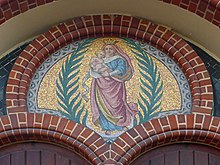Mary of the Rosary Queen (Genthin)
The church Maria Rosenkranzkönigin , also called Sankt Marien for short , is the parish church of the Catholic parish Sankt Marien in Genthin , a small town in the district of Jerichower Land in Saxony-Anhalt . It belongs to the deanery of Stendal of the diocese of Magdeburg .
history
In the 16th century, Genthin became Evangelical Lutheran through the Reformation . In 1538 the first Lutheran preacher was employed in Genthin.
From the 19th century onwards, as a result of industrialization and the expansion of transport connections, Catholics began to settle in Genthin again. From 1896 Genthin had a Catholic priest again in the missionary vicar August Habbel . The church building site was purchased in 1897, and a Catholic school opened in 1898.
In the autumn of 1902 the foundation stone was laid by Provost Franz Schauerte , the episcopal commissioner of Magdeburg. On June 23, 1903, the church was inaugurated by Wilhelm Schneider , bishop of the Paderborn diocese , to which Genthin was a member at the time. In 1908 the church got an organ and heating. In 1931 the organ was expanded and in 1938 the heating was renewed.
On June 1, 1943 the parish Genthin was established. After the Second World War , the number of Catholics in the Genthin area increased due to the influx of refugees and expellees from the eastern regions of the German Empire . As a result, Catholic chapels were set up in some of the surrounding villages: 1957 in Ferchland , 1963 in Güsen , 1964 in Jerichow and 1970 in Parey .
The church building was renovated in 1950, 1962 to 1964, 1979, 1980 after a fire and in 1988. A lantern that was originally on the saddle roof of the church tower had to be removed in 1969 because it was dilapidated . In 1986/87 the parish hall was demolished and rebuilt, and in 1988 a new heating system was installed in the church.
Because the number of believers and priests decreased again in the course of the GDR era and also after the fall of the Wall , the chapels were given up again, initially the chapel in Güsen in 1988. The peaceful revolution in Genthin began in the church on October 25, 1989, a plaque on the entrance gate reminds of this today. In 1991 the organ was renewed and the chapel in Ferchland was closed. In 2003 the church got a new interior painting. On March 1, 2006 the community association Genthin - Kirchmöser - Tuchheim - Ziesar was established. In the same year the church roof was renewed and the chapel in Jerichow was given up.
In 2010 the chapel in Parey was closed, and on May 2, 2010, the current parish of Genthin emerged from the community. In 2011 the chapel in Tuchheim was also closed. The 2011 census in the European Union showed that of the 15,036 inhabitants of the city of Genthin, 430, or around 2.9%, belonged to the Roman Catholic Church. The majority of the inhabitants did not belong to any religious community. The catchment area of the parish Genthin extends today in the east to the border with the Archdiocese of Berlin , in the south to far south of Autobahn 2 , in the west to the Elbe and in the north to just before Tangermünde .
Architecture and interior design
The church building was built in the neo-Romanesque style under the direction of the district architect Engelbrecht . The style is based on the former Jerichower monastery church , which is located on the parish territory. The church tower is located northeast of the nave. A tall side annex was built on the north side of the ship. On the east side there is a porch with a pent roof across the full width of the nave . In the middle is the risalit- shaped church portal. Above the entrance, a crescent moon Madonna , similar to the Genthiner city arms, is depicted as a mosaic between palm leaves .
The ceiling of the nave is made of wood and stepped in three parts. The ceiling beams are decorated with ornaments . The choir ceiling is designed as a groin vault. In the nave there are several colored window panes that were made in the 1940s. The windows were created by the Quedlinburg company Ferdinand Müller according to plans by W. Rittenbach and depict the Annunciation , the birth of Jesus, as well as the crucifixion and Pentecost . The colored glass windows in the apse , which depict Saints Liborius and Norbert , date from the construction period .
In the northern extension there is an organ gallery with an organ created in 1908 by Wilhelm Rühlmann senior from Zörbig .
literature
- Folkhard Cremer in: Dehio-Handbuch der Deutschen Kunstdenkmäler, Saxony-Anhalt I, administrative district Magdeburg. Deutscher Kunstverlag , Munich / Berlin 2002, ISBN 3-422-03069-7 , page 251.
Web links
Individual evidence
- ↑ https://www.lkjl.de/de/geschichte.html
- ↑ http://www.bistum-magdeburg.de/aktuelles-termine/presse-archiv/archiv-2006/st.-marien-erhaelt-neues-dach.html
Coordinates: 52 ° 24 ′ 30.1 ″ N , 12 ° 9 ′ 15.4 ″ E

